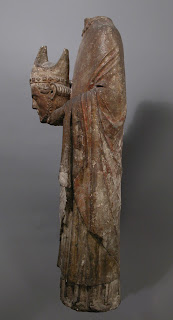Embark on a historical journey with a visit to the Metropolitan Museum of Art, home to a striking 13th-century French limestone sculpture of St. Firmin, the fourth-century multitasker. Explore the mesmerizing world of medieval art and uncover the enigmatic saint's intriguing tale of unwavering faith, becoming a bishop, and his peculiar post-decapitation joy.
I am at the Metropolitan Museum of Art today, and I embark on a captivating journey through time as we explore the mesmerizing world of medieval art at the Metropolitan Museum of Art. Our focus lies on an intriguing 13th-century French limestone sculpture of none other than St. Firmin, a high-achieving multitasker hailing from the fourth-century (i.e., a Roman Catholic Saint with a penchant for carrying his decapitated head).
Encountering St. Firmin, the ultimate multitasker from the 4th century, at the #MetropolitanMuseumOfArt today. 🎨🏛️ Staring at this 13th-century French wooden sculpture, it's clear this #Saint wasn't your average holy man! 😇🙏 Quickly ascending the celestial corporate ladder, he claimed the coveted position of Bishop at #Amiens.
But here's the quirky part — he's joyfully holding his head! Yes, you read that right. A case of post-decapitation bliss, perhaps? 😂🤔 Nevertheless, he seems quite content. Go, hun!
A day well spent appreciating #ArtHistory and uncovering some divine oddities. Truly, there's nothing like a #SaintStory to keep things interesting! 💫📖
As we stand before this masterful creation, we can't help but wonder about the life and accomplishments of this enigmatic saint. St. Firmn's journey was one of immense determination and unwavering faith. Climbing the celestial corporate ladder, he eventually earned the esteemed position of bishop at Amiens, France – a feat that undoubtedly demanded great dedication and virtue.
Yet, what truly captivates us is the portrayal of St. Firmin holding his head in his hands, an expression of joy illuminating his features. His happiness and contentment in this sculpture are palpable, leaving us with the question: What was the source of his boundless joy?
 |
| Saint Firmin |
Indeed Saint Firmin is a real person and is said to have been beheaded in Amiens, France; his feast day is celebrated on September 25th. However, historical records do not confirm the exact year of his death. It's believed to have occurred during the early 4th century, possibly around 303 C.E. Miracles attributed to the discovery and translation of his relics during the time of Bishop Savin are part of the saint's hagiography.
Steeped in history, medieval art provides a rich tapestry of stories that often speak to the human experience. St. Firmn's sculpture is no exception. The depiction of a saint holding his head symbolizes his unwavering devotion to the church, even amidst the trials and challenges he faced. Also, Saint Firmin is a martyr, which means he gave up his life for his belief and devotion to Christ. In this way, martyrs are often depicted in the same way they were killed — in this example, by cutting off the poor saint's head. To illustrate that for the Christian — death is not the end, but a beginning — he carries his head as a defiance against the ravages of sin and death. And how are you doing?
Seeing such a treasure trove of medieval pieces at the Metropolitan Museum of Art is also cool. The museum serves as a befitting venue for our encounter with St. Firmn. Its halls house an extensive collection of art that transcends time, mimicking the architecture of a Gothic cathedral, allowing us to connect with our past and embrace the beauty of diverse cultures and histories.
So, next time you find yourself at the Met, take a moment to visit this 13th-century French limestone sculpture and meet the remarkable St. Firmn. Witness his joy and dedication, and let it be a reminder that happiness lies in pursuing our passions and fulfilling our purpose in life. Keep your head on properly.
In conclusion, a visit to the Metropolitan Museum of Art can be more than just an exploration of history – it can also be an introspective journey, connecting us with the triumphs and struggles of those who came before us. Let St. Firmn's story inspire us as we continue our paths, aiming to find joy and fulfillment in our endeavors, just as he did in the fourth century.

